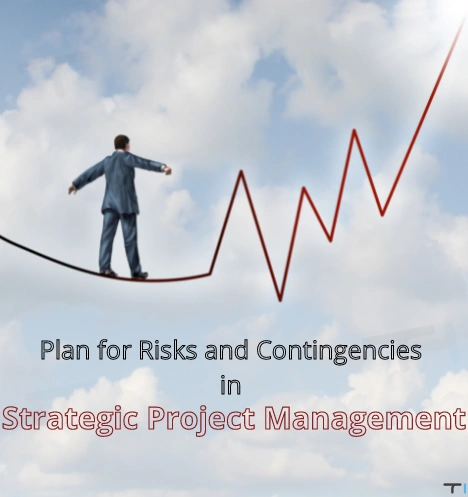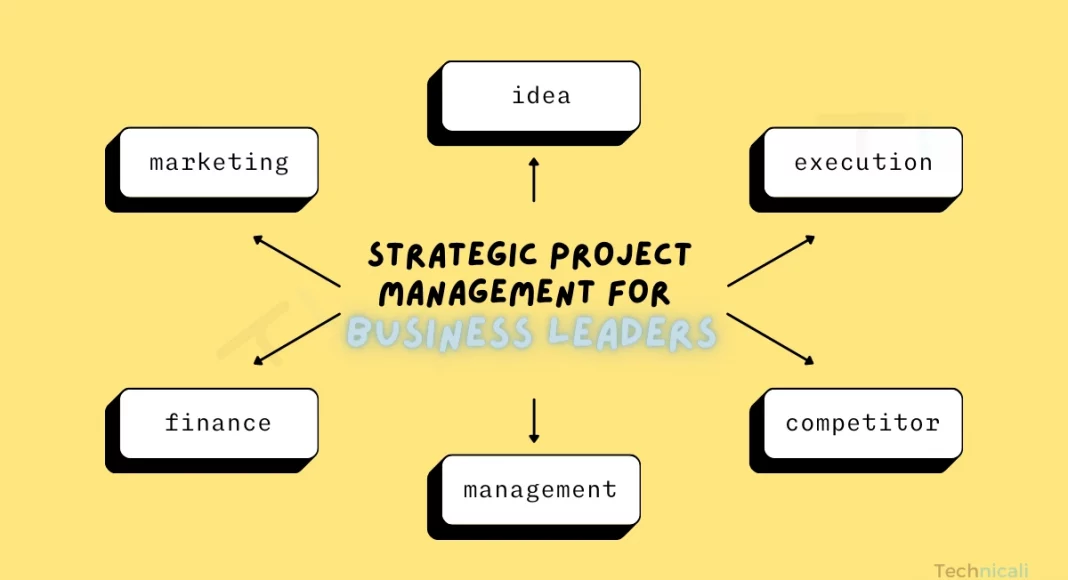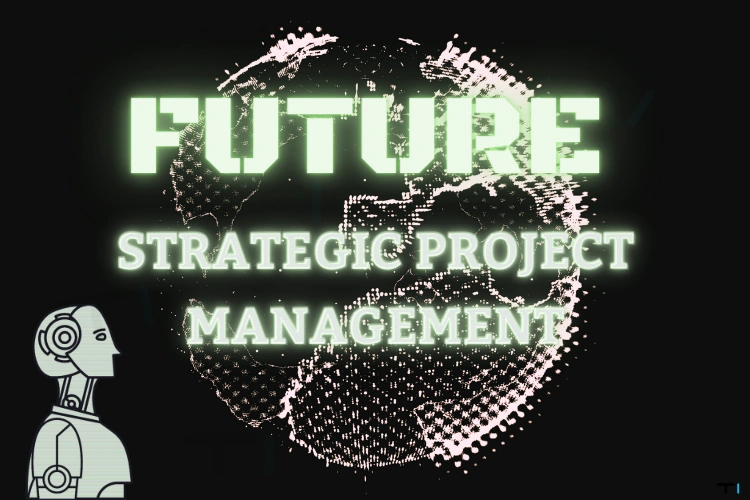So you want to be a strategic project manager, huh?
Project management is a critical aspect of any business, and strategic project management takes it to the next level.
By aligning projects with business goals, using the right tools and techniques, and implementing a successful plan, businesses can achieve great things.
In this article, we’ll explore what strategic project management is, the steps involved, how to get started, and the benefits of this approach.
It’s not an easy task, but if you’re up for the challenge, then read on!
Contents
What is Strategic Project Management?

Strategic project management is the process of aligning projects with business goals to achieve desired outcomes <- In simple terms.
It involves setting clear objectives, understanding the resources available, and planning and executing projects in a way that matches the required standing with greater chances of success.
It also involves implementing a successful plan to deliver the project’s objectives.
The benefits of strategic project management include:
- Improved alignment with business goals: By definition, strategic project management ensures that projects are aligned with business goals. This alignment allows businesses to prioritize their resources and efforts to achieve the greatest impact.
- Better use of resources: When projects are aligned with business goals, businesses can better understand which resources are required and how to best use them. This can lead to improved efficiency and effectiveness, and ultimately, savings on costs.
- Increased chances of success: By understanding the business goal, the risks involved, and having a plan in place to address these risks, businesses increase their chances of success.
- Improved communication and collaboration: Strategic project management requires clear and concise communication between all stakeholders. This ensures that everyone is aware of the objectives, progress, and any potential issues.
The steps involved in strategic project management
There are several steps involved in strategic project management, including:
- Defining Objectives: The first step is to define the objectives of the project clearly and what success looks like.
- Understanding Resources: The next step is to understand the resources available, both within the organization and externally. This includes things like time, money, and skills.
- Planning: Once objectives are clear and resources are understood, it’s time to develop a plan for how the project will be executed.
- Execution: The final and the most important step is to carry out the project according to the plan and monitor progress along the way.
- Evaluation: After the project is complete, it’s essential to take some time to evaluate what went well and what could be improved for future projects.
Well, it’s not as easy as it looks.
You can’t just jump into it without some preparation. The above 5 steps are just to help get you started on the right foot.
If you want to achieve great things with strategic project management, it’s important to understand the steps involved and how to get started.
How to Ensure Projects are Aligned with Business Goals
There are several ways to ensure that projects are aligned with business goals, including:
- Defining objectives upfront: As mentioned above, one of the most important steps in strategic project management is to define objectives clearly. This ensures that everyone involved in the project is aware of what needs to be accomplished
- Involving stakeholders early on: Another way to ensure alignment is to involve stakeholders in the project from the beginning. This gives them a chance to provide input and feedback throughout the process
- Using the right tools: This is most important, as you can’t communicate with each resource but you can use the right tools that align with your project, such as goal setting templates, kanban charts, time trackers, and project management software.
- Creating a business case: A business case is a document that outlines the reasons for undertaking a project. It should include an analysis of the benefits, costs, and risks associated with the project.
- Getting buy-in from senior management: One of the best ways to ensure alignment is to get buy-in from senior management. This shows them that you’re committed to the project and that it aligns with their goals.
Tools and Techniques that can help with Strategic Project Management
There are various tools and techniques that can help with strategic project management, including:
- Goal setting templates: These can help define objectives and ensure that everyone involved in the project is on the same page
- Project management software: This type of software can be extremely helpful for tracking progress, keeping everyone organized, and ensuring that projects are completed on time and within budget

- Communication tools: Since communication is key in any project, using the right tools can make a big difference. This includes things like video conferencing, instant messaging, and project management forums.
- Customer Relationship Management tools: Keeping track of customer needs and expectations is essential for any business. Having a good CRM system in place can help project managers stay on top of this

- Risk management tools: It’s important to identify and manage risks throughout the project lifecycle. There are various tools that can help with this, such as risk register templates and risk assessment.
- Enterprise Resource Planning tools: ERP systems can be extremely helpful for managing all aspects of a project, from finances to inventory to resources.

The Benefits of Strategic Project Management for Businesses
There are many benefits of strategic project management for businesses, including:

- Improving project success rates: By aligning projects with business goals and using the right tools and techniques, businesses can improve their chances of project success
- Better resource utilization: Strategic project management helps businesses to better understand and utilize the resources available to them. This can lead to improved efficiency and cost savings
- Increased customer satisfaction: When projects are managed in a strategic way, it often leads to increased customer satisfaction. This is because customer needs and expectations are better understood and taken into account
- Improved communication: Good communication is essential for any successful project. By using the right tools and techniques, businesses can improve communication both within the team and with external stakeholders
- Greater stakeholder buy-in: When projects are managed in a strategic way, it often leads to greater buy-in from stakeholders. This is because they are involved early on and their needs are taken into account
- Increased flexibility: Strategic project management helps businesses to be more flexible and adaptable. This is because the approach encourages constant review and feedback, which can help identify areas that need to be changed or improved
- Improved project visibility: By using tools like project management software, businesses can improve visibility into all aspects of the project. This allows for better decision making and increased control
- Enhanced reputation: When businesses successfully complete projects, it often leads to an enhanced reputation. This can help attract new customers and business opportunities
- Improved employee morale: When projects are managed effectively, it can lead to improved employee morale. This is because employees feel valued and appreciated, and they have a greater sense of ownership over the project.
- Greater efficiency and cost savings: By using the right tools and techniques, businesses can achieve greater efficiency and cost savings. This is because less time and resources are wasted on tasks that don’t align with the project goals.
With so many benefits, it’s clear to see why strategic project management is such an important part of any business.
Real-world examples of companies that have benefited from Strategic Project Management

There are many companies that have benefited from strategic project management. Here are just a few examples:
- Amazon: Amazon is a company that is well-known for its use of technology. By using tools like Amazon Web Services and JIRA, they’ve been able to improve the efficiency of their operations and save costs. In addition, they’ve used project management techniques to deliver successful projects, such as their Kindle e-reader.
- Google: Google is another company that has used technology to its advantage. By using tools like Google Drive and Google Workspace, they’ve been able to improve the way they work and save money. In addition, they’ve used project management principles to deliver successful products.
- Meta Platforms: Meta (Primarily Facebook) is a social networking company that has used project management techniques to deliver successful projects. For example, they used agile methodology to develop their apps on the google play store and apple store. In addition, they’ve used tools like Jira and Asana to manage their progress.
- Apple: Apple is a company that is well-known for its innovative products. By using project management principles, they’ve been able to bring these products to market quickly and efficiently. In addition, they’ve used tools like SAP and Salesforce to manage their work, and customer relationships and keep track of progress.
- Microsoft: Microsoft is a company that has used project management principles to deliver successful projects. For example, they used agile methodology to develop their Windows operating system. In addition, they’ve used tools like Microsoft Project and Dynamics to manage their workflow.
How to Get Started with Strategic Project Management in your own Business
If you’re interested in using strategic project management in your own business, there are a few things you need to do
- Define your business goals: The first step is to clearly define your business goals. What are you trying to achieve? What are your long-term and short-term goals? Once you have a clear understanding of your goals, you can start to align your projects with them.
- Use the right tools and techniques: The next step is to use the right tools and techniques. There are many different project management tools and techniques available, so it’s important to choose the ones that will work best for your business.
- Implement a successful plan: The final step is to implement a successful plan. This includes setting clear objectives, timelines, and milestones. It’s also important to assign roles and responsibilities to team members. By doing this, you can ensure that the project is completed on time and within budget.
- Get started today: The best way to get started with strategic project management is to start today. There are many resources available to help you, so don’t delay. Start by defining your business goals, choosing the right tools and techniques, and implementing a successful plan. You’ll be glad you did!
Plan for Risks and Contingencies in Strategic Project Management

What’s the deal with strategic project management? If you can’t plan for risks and contingencies, you might as well not bother doing it at all.
Risks and contingencies are an inherent part of any project. By definition, a risk is something that could potentially happen that would impact the success of the project. A contingency is a plan that is put in place to deal with risk if it does occur.
The key to managing risks and contingencies is to identify them early and then put a plan in place to deal with them. This can be done by creating a risk register which is a document that lists all of the potential risks for a project along with the plans for dealing with them.
Once the risks and contingencies have been identified, it’s important to monitor them throughout the project. This can be done by periodically reviewing the risk register and updating it in the Evaluation Step of the project life cycle.
It’s also important to have a plan for dealing with risks and contingencies if they do occur.
This plan should be designed to minimize the impact of the risk on the project.
Start by identifying the risks and contingencies for your project and then put a plan in place to deal with them. You’ll be glad you did!
The Future of Strategic Project Management
The future of strategic project management is looking bright! With so many businesses using project management principles to achieve success, it’s clear that this approach works. And as technology continues to evolve, the tools and techniques available for project managers will continue to improve.
One trend that we’re seeing is the move towards agile methodology. This approach is becoming more popular due to its ability to quickly adapt to changes. As businesses become more agile, they need project management tools and techniques that can keep up with changing world, gives more control, and illustrates progress.
We may also see a rise in the use of artificial intelligence (AI) and machine learning (ML) to help with things like resource utilization and risk management.
Being Strategic can’t rely upon one person but we need to have templates of various strategies, frameworks, and methods that can be split tested and modified with our company’s specific goals and objectives. Businesses are under pressure to do more with less. In addition, after all this covid and war news; new tools and technologies will continue to emerge so management can be simplified and improved.
Another trend is the increasing use of cloud-based solutions. This allows team members to collaborate on projects from anywhere in the world. And as mobile devices become more prevalent, we can expect to see even more use of cloud-based solutions in the future.
The future of strategic project management is likely to see more businesses adopting this approach.
Reply to me on Twitter or comment below!


